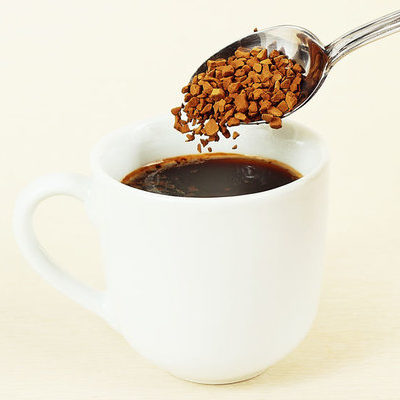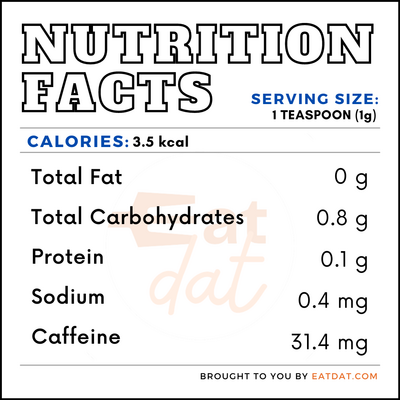
Instant Coffee
What is Instant Coffee?
Instant coffee is a beverage produced from roasting, grinding, and brewing coffee beans. It is also known as soluble coffee or coffee powder.
- Many people all over the globe consume instant coffee, as it is fast and easy to prepare compared to regular coffee.
- The two main ways of commercially producing coffee powder are the spray-drying or freeze-drying processes.
The top ten brands in the US, according to Caffeine Informer are:
- Starbucks Via Ready Brew Coffee
- Mount Hagen
- Maxwell House
- Nescafe Clasico
- Douwe Egberts Pure Gold
- Folgers
- Starbucks Via Ready Brew Decaf
- Nescafe Taster’s Choice
- Jacobs Kronung
- Four Sigmatic Mushroom Coffee
Origin of instant coffee
Instant coffee was first made in Britain in 1771 and the British government even granted a patent for it. Much later, in 1851, the first American instant coffee was made. David Strang of New Zealand patented his version of this coffee in 1890. Satori Kat, a Japanese-American chemist, invented the first stable instant coffee in 1901 and later in 1903, the method was patented. The instant form of this beverage became famous in WWI for its ease of use. The US military distributed it to soldiers, making it a ubiquitous drink.
In 1937, Max Morgenthaler, a Nestle scientist, created another way of making coffee powder and named it Nescafe. Nescafe coffee would also become well-known in World War II. In the 1960s, a higher quality of coffee entered the scene. In 1986, Nestle introduced coffee powder that had no caffeine. Today, people still drink coffee as much as ever, as it has a way of keeping individuals active throughout their daily activities. In 2020, coffee has generated a revenue of $67.663 million in the United States.
Nutrition
In 1g of instant coffee, there is:

According to health studies, this drink may provide these health benefits:
- It can speed up the body’s metabolism and burn excess fat.
- Instant coffee can help to boost brain function.
- It may be capable of helping the liver against diseases.
- Instant coffee can be instrumental in helping mental health.
- It may help reduce the risk of developing type 2 diabetes.
In 1991, WHO classified coffee as a substance capable of causing cancer, although recent studies in 2016 dispelled this claim. Coffee powder does not increase your risk of developing cancer. In fact, it can minimize the risks of certain types of cancer. Different people have varying tolerance levels for the caffeine in coffee. Small to medium amounts of caffeine can make you bright and energetic, whereas high amounts can lead to restlessness and sleeplessness.
Commercial production
The following steps summarize the freeze-drying process of making coffee:
- Roasting: This stage involves roasting the beans in a giant roaster at 230°C. The color of the beans transforms from green to brown. The beans are then quickly cooled after 10 minutes of roasting to prevent any further cooking.
- Grinding: An industrial roller-mill grinds the roasted coffee beans. The coffee loses a lot of aroma during grinding. Nitrogen gas pumped through the ground is used to absorb the vapor and a tank stores the aroma for later.
- Brewing: This process involves mixing the ground coffee with water in a large extraction pod.
- Evaporation: This stage involves warming the already brewed and filtered coffee. The coffee is pumped through pipes into a large evaporation tank. During warming, the water in the coffee evaporates and what is left behind is a thick coffee extract.
- Freezing: Heat exchangers pre-chill the coffee extract first. Then, a conveyor belt moves the extract into a giant freezer with a temperature lower than the North Pole. The next thing is breaking the coffee into granules, although these granules still have water in them.
- Sublimation: The coffee granules are stacked on trays. Under low pressure and heat for hours, sublimation turns frozen water in the granules directly into steam. This prevents the coffee from losing the aroma left in it. At room temperature, the granules now remain in a solid state.
- Re-addition of aroma: The aroma stored in the tanks earlier is sprayed over the granules.
- The last step is to package the coffee.
Spray drying is a less common way of making instant coffee. This is because spray drying results in loss of aroma and low-quality coffee.
Application
Making the perfect coffee is very straightforward. Simply boil water. Then, add the powder to the hot water. Finally, add milk and sugar according to your taste.
Bear in mind that coffee can get stale over time. It also absorbs aromas and moisture. The best place to store this is in an opaque, airtight, properly sealed container. This method keeps moisture and light from affecting the coffee.
Instant coffee recipes
This coffee can be adjusted to suit many tastes. Here are a few recipes you can try out:
- Instant Iced Coffee
- Chilled Nutella Coffee
- Creamy Iced Coffee
- Whipped Coffee
- Vanilla Mocha Iced Coffee
- Irish Coffee
- Almond Milk Mocha
FDA regulation
The Food and Drug Administration has regulations that guide the importation, processing, and preparation of coffee. These guidelines state how coffee beans should be handled to prevent low quality yield and disease infestation. The FDA also has regulations concerning the volume of additives that can be added to decaffeinated ground coffee and soluble coffee extract.
References
Bjarnadottir, Adda. “Instant Coffee: Good or Bad?” healthline.com, Healthline Media, 8 Oct. 2019, www.healthline.com/nutrition/instant-coffee-good-or-bad.
Cook, Nigella. “How to Make the Perfect Cup of Instant Coffee.” Delishably.com, Delishably, 26 Dec. 2019, delishably.com/beverages/How-to-Make-the-Perfect-Cup-of-Instant-Coffee.
Office of the Commissioner. “Caffeine and Kids: FDA Takes a Closer Look.” US Food and Drug Administration, FDA, 5 Mar. 2013, www.fda.gov/consumers/consumer-updates/caffeine-and-kids-fda-takes-closer-look
